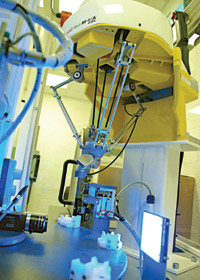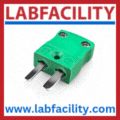
Posted to News on 23rd Apr 2012, 00:00
Automation in the service of health
Assembly and handling technology, robotics and machine vision can provide significant advantages to the medical, pharmaceuticals and cosmetics industries with respect to productivity, precision and quality.

>Automation technology is being used increasingly in the medical, pharmaceuticals and cosmetics industries. It is helping these innovative industries to launch products onto the market more quickly and achieve more economic production. Robot manufactures and other automation providers have been concentrating on the multifaceted needs of these industries for years. They can provide sophisticated technologies today. On one hand, they provide multi-axis robot solutions for grinding and polishing of implants. On the other hand, they also provide simpler but usually highly precise automation units. Corresponding sensors, grippers and vision systems are also available.
>Engineer Dr. Andreas Pot, group leader of intralogistics at the Fraunhofer Institute for Production Technology and Automation (IPA) in Stuttgart, confirmed the availability of suitable robots and automation components for use in the medical, pharmaceuticals and cosmetics industries. He distinguishes two kinds of requirements, which must be fulfilled depending on use. "Many robots must be suitable for production-related use under clean room conditions - in other words, strict guidelines with respect to materials used and particles released. Strict hygiene requirements apply to other uses, such as we know from the foodstuffs industry. These are both no problem for robot technology. Many companies provide especially designed models, which can also be certified correspondingly."
>The number of robots used in the medical, pharmaceuticals and cosmetics industries is increasing rapidly. Robot solutions, which are used in operating theatres and directly on patients, require extremely sophisticated technology. However, these uses play a subordinate role with respect to robot figures, because these are mainly special solutions. Most robots are used in standard applications - typically pick and place tasks, whose main challenges are the highest possible number of picks per minute and increased flexibility.
>This requires extremely fast robots, usually reliable machine vision and integration of line tracking functions. Delta robots - parallel kinematics with up to six axes - are an ideal solution for such pick and place tasks. They usually cannot handle very heavy loads, but they are extremely fast. For increased flexibility, these robots are often equipped with additional vision systems. This enables controlled access to different objects. One robot manufacturer recently started offering delta robots with a pre-installed vision system that can even handle colour processing. As a result, differently coloured tablets can be placed precisely in packaging, for example.
>Colour processing and 3D vision
>Industrial machine vision has become generally established in many medical and pharmaceutical areas. There has been significant progress in colour processing and 3D vision, which opens up numerous new automation possibilities. For example, colour-processing vision systems are used in cytology or cytodiagnosis and pathology for tissue and carcinoma recognition. To detect complex structures such as cells and dendrites, however, reliable colour classification is required, which in turn requires high-performance image-processing software.
>3D procedures have also achieved significant performance increases, which is making medical image analysis increasingly important. Using the light-slit method, for example, a drilled tooth can be scanned three dimensionally using a laser line, which produces a 3D module of the inlay to be produced. Then a robot precisely grinds the dental restoration based on this model.
>In the pharmaceuticals industry, machine vision is primarily used for quality controls in manufacture of drugs. Its applications include monitoring crystal growth and fill levels of ampoules. The colour of tablets and the absence of damage to blisters can also be checked using modern vision systems. There is even a suitable solution for package inserts and packaging with print image control (OCV).
>Assembly systems have long been making an important contribution to optimised productivity and quality in the manufacture of small medical engineering devices such as auto-injectors and inhalers. In addition to numerous improvements in details, a basic trend to modularly set-up systems can be seen. This is primarily due to economic reasons, because the time-saving in obtaining approval with early process validation and consequently reduced time to market launch is enormous.
>A prerequisite for this is a machine platform, which can be expanded from a pilot system to a high-performance production facility. A manual workstation with partially automated inspection and assembly operations can be constructed for a device still in the development stage, with which all critical process can already be qualified in their final configuration in this pilot system. These processes are then transferred 1:1 into a semiautomatic assembly line and finally into a completely automated further phase.
>Automation solutions for the medical, pharmaceutical and cosmetics industries are among the innovations you can expect to see at Automatica 2012, held in Munich from 22-25 May.




